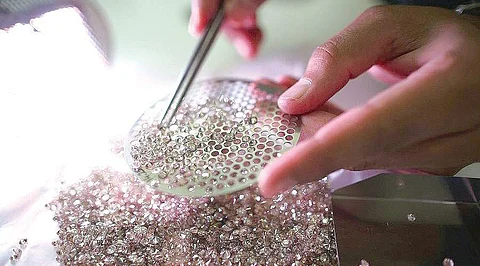

It was a strange exit for Rio Tinto. After years of developing the Bunder mines in Madhya Pradesh for commercial rough diamonds since 2004, the mining giant formally handed over the project to the state government on February 7. It had stopped mining operations last August.
Why did Rio Tinto pull out so abruptly after 12 years of prospecting and mining operations? The firm’s former Bunder project director Stefanie Loader had told this writer years ago that, by 2011, Rio Tinto had sunk Rs 185 crore in prospecting and other operations and that it was spending Rs 22 crore a month to bring the mine to commercial production.
A back-of-the-envelope calculation shows that by 2016, the mining giant had put in nearly Rs 1,200 crore into a Rs 2,200-crore project expected to deliver a commercial yield of 27.4 million carats of roughs.
With that kind of value, the Bunder mines would have catapulted MP among the top 10 diamond producing regions in the world.
In a statement that hides more than it says, Rio Tinto Copper & Diamonds chief executive Arnaud Soirat said in February: “Our exit from Bunder is the latest example of Rio Tinto streamlining its asset portfolio. It simplifies our business, allowing us to focus on our world-class assets. We believe in the value and quality of the Bunder project and support its future development, and the best way to achieve that is to hand over the assets to the Government of Madhya Pradesh.”
Real reasons
The real reasons probably are that years of environmental opposition and lack of state support made the project unviable for the mining group. Ecological impact was a genuine worry and the location of the Bunder mines near a Tiger wildlife corridor brewed opposition. A government study said five lakh trees may need to be cut if Rio Tinto’s open cast mining was accepted, and pressure was put on the company to adopt the less invasive but more expensive underground operation. A source from the group told Express: “After all these years, we had not been able to get past the ‘prospecting licence’ stage.”
So, now what happens to the Bunder-Chattarpur mines? The current custodian of the project, the MP government, does not have the technology or the funds to pursue commercial production. There is also concern in the large Indian diamond polishing and exporting industry that India’s first big find of roughs has gone a-begging.
On the sidelines of a recent World Diamond Conference in Mumbai recently, Gems & Jewellery Export Promotion Council chairman Praveenshankar Pandya proposed to Russian deputy premier Yuri Trutnev that a 50:50 joint venture be set up between the Indian industry and Russian mining giant Alrosa to develop the Bunder mines.
But, will Alrosa step into the Bunder quicksand? And, what is the guarantee Alrosa will be able to cross the environmental minefields that hit Rio Tinto? Pandya was not forthcoming but told the Express that the reasons for the withdrawal of Rio Tinto were “more complex than it seems”.
The initial enthusiasm of the Australian giant and its sudden departure show the script for foreign investments is not clear. The recent exits of POSCO from
Odisha, or Arcelor Mittal from Jharkhand and Odisha, prove the environmental bye-laws are far from settled in the country; and attracting new investment in mining and heavy industry is going to get tougher as failures, like the Bunder project, sink in with the world community.
Deep crisis
The crisis is sharper if seen in the overall picture. India has emerged as a hub for high-quality cut and polished diamonds and is the largest exporter in the world. However, the international slowdown, especially the fall in demand from the US, has hit the gems industry hard.
In FY16, cut and polished diamond exports accounted for $20 billion, a steady fall from $25 billion in FY14 and $23 billion in FY15.
On the other hand, as a producer of roughs, India accounts for a negligible just Rs 5-10 crore annually from MP’s Panna mines. Almost all the diamonds being processed in India are imported, 60 per cent or more through the hub of Belgium. Internationally, the mining of rough diamonds is getting tougher, and facing falling volumes.
No fresh mines have come on stream in the past 10 years, and the older mines such as Rio Tinto’s Diavik mines in Canada are coming close to the end of their life cycle.
A recent RBC Capital review estimated that a variety of factors including the growth of synthetic diamonds will bring down supplies from a high of 145 million carats in 2018, through a steady fall, to 105 million carats in 2030. This means tough times and higher prices of roughs for the local polishing and cutting industry.
It is no wonder there is urgency among local diamondtaires to encourage local sourcing of roughs. Both MP and Chhattisgarh are said to be rich in deposits. They have been pitching with big mining groups such as De Beers and Alrosa to begin prospecting in these states. But, given the experience of Rio Tinto and no viable prospecting policy, these multinational companies might not take the bait.
(The writer is a senior journalist)